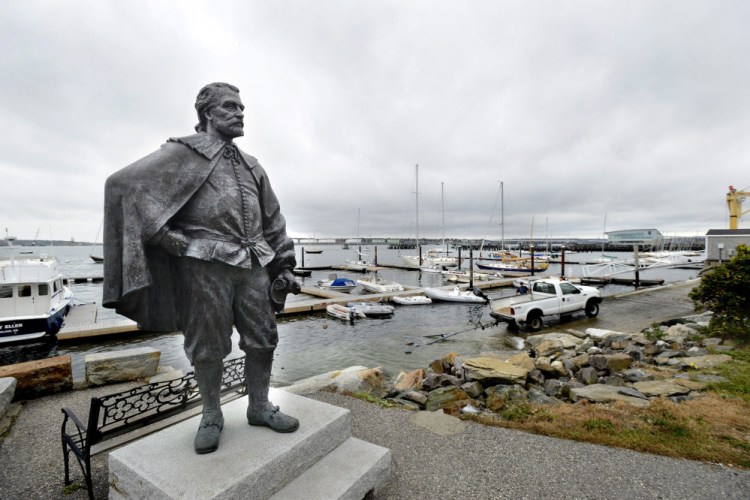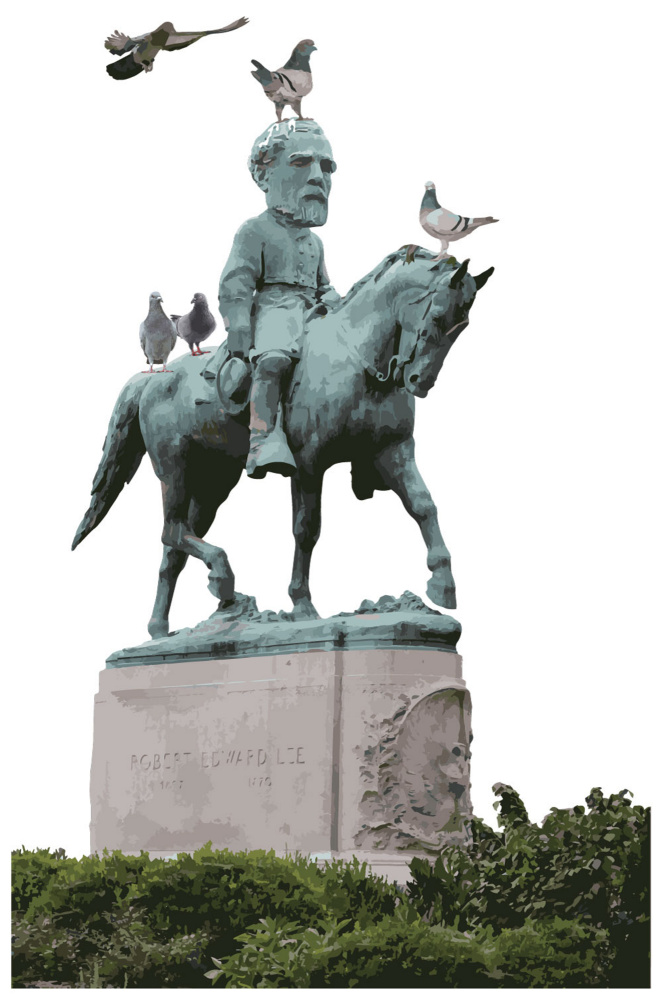In 2013, the Portland City Council rejected a gift of a 7-foot bronze statue of George Cleeve, the city’s ostensible founder, because of his relationship to slavery. The statue now looks out over the port from private land at Portland Yacht Services.
In 2015, Bowdoin College removed a 21-by-25 inch plaque from the lobby of Pickard Theater and placed it in the college library’s special collection. That plaque lists the names of 19 Bowdoin alumni who fought for the Confederacy and Jefferson Davis who, in 1858, received an honorary degree from Bowdoin – well before he was elected president of the Confederacy and declared war against the United States of America.
The plaque was mounted at Bowdoin in 1965 during a peak of the American Civil Rights struggle, a moment coinciding with the 100th anniversary of the Confederate Army’s formal surrender at Appomattox, overseen by none other than erstwhile Bowdoin College professor Joshua Chamberlain, the hero of Gettysburg.
Few would argue that a plaque is a work of art. This particular plaque was placed by the United Daughters of the Confederacy, a group whose name has come up repeatedly in the recent conversations about the controversial Confederate markers so many Americans are calling to have removed.
The news last week was dominated by the strife in Charlottesville surrounding the removal of a statue of Confederate Gen. Robert E. Lee. I hear people saying “this isn’t about statues” and others talking about the Confederate monuments as though they were art. First of all, few – if any – of those monuments are art. Secondly, it is about the statues. Lee, by the way, wrote after the war that he was against the idea of Confederate monuments.
Most of us have family portraits framed like paintings on the walls of our homes. They’re often our most precious possessions, but we don’t claim them to be art.
As an art critic, my job is to comment on the distinction between what is worthy art and what is not. We need to remind ourselves at this cultural moment that not everything that shines in a frame on the wall or sparkles on a public pedestal is art.
Since WWII, a common art-or-not conversation in America has concerned the distinction between art and craft. I reject that dichotomy, preferring to talk about the continuum between art and kitsch – with the idea that kitsch represents “non-art.”
A key non-art quality is propaganda. Not all propaganda is non-art, to be sure: Consider Joe Rosenthal’s “Raising the Flag on Iwo Jima,” the iconic photograph depicting United States Marines raising an American flag during World War II’s Battle of Iwo Jima. Beyond the jingoism, Rosenthal’s image depicts struggle, teamwork, triumph and features historical narrative qualities and a fresh take on the classical pyramidal composition championed by none other than Leonardo da Vinci.
However, the message of architectural monuments is generally driven by the groups that fund or vote for them. If Congress, for example, orders a monument to Obama, Bush or even George Washington, it’s not necessarily art. Consider that the Washington Monument was put on the table in 1783, construction began in 1854 and yet it wasn’t opened until 1889, ground to a halt again and again by controversy.
Moving forward, consider a warrior that Ronald Reagan supported in the successful proxy fight against the Soviets in Afghanistan. The Cold War victory was a huge moment for America. The warrior I am talking about, however, was Osama bin Laden. Would any American city support a statue of bin Laden? Certainly not. After all, he attacked the United States with spectacular bloodshed on Sept. 11. Well, remember that Lee and the Confederates killed more American troops than Hitler, Ho Chi Minh, bin Laden or anyone else.
I think monuments to Lee would be akin to monuments to bin Laden or Timothy McVeigh. But there’s more to this than the question of whom to honor. Because of the Confederacy’s dedication to slavery and ensuring blacks did not become American citizens, its symbols, such as Lee, Davis and the Confederate Battle Flag, are – above all else – symbols of hate.
Message and content matter. Morals matter. It’s one thing to honor societal values – and I think that is visual art’s great cultural ability. But it’s another thing to demean other humans based on identity or race. Our society, after all, is built on the Constitution, the goals of which were “to form a more perfect Union, establish Justice, insure domestic Tranquility, provide for the common defense, promote the general Welfare, and secure the Blessings of Liberty to ourselves and our Posterity.”
If a municipality can vote a Confederate statue into place, it’s clear the scales of justice aren’t balanced – and that is precisely the message those Jim Crow-era statues were intended to send to African Americans as well as white supremacists. You certainly can’t “insure domestic tranquility” where official symbols brazenly announce the racism of the people in power.
The content and messages of much of the 700 Confederate monuments in America comprised a triumphant response to the Jim Crow laws enacted a century ago in the states that had formed the Confederacy. The messages were not the articulations of individual artists, but the result of democratically elected councils and leaders who sought to reclaim the values of the Confederacy, the “foundations” of which, according to Davis’s vice president Alexander Stephens, “are laid, its cornerstone rests, upon the great truth that the negro is not equal to the white man (….) Slavery subordination to the superior race is his natural and normal condition.”
That was the cornerstone of the Confederacy. And that is the message of Confederate symbols. The swastika didn’t start out as a symbol of anti-Semitism, but that’s what it is now. The Confederate Battle Flag only became popular in the 1950s as a way to give the finger to the anti-segregationists and remind black citizens who was in charge. And now, like the swastika, it is a tool for racial terrorism.
So does it matter if a racist statue is a work of art? This is a big question, but consider this: If a project proposed by a municipal committee is a building that becomes antiquated, what do you do? You can upgrade it or tear it down. And we’re talking about hateful objects that were often mass-produced, the messaging of which was rarely, if ever, in the hands of commissioned artists. So, yes, these things are generally far more akin to outdated architecture than to works of art. Tearing down an outdated bit of architecture is not iconoclasm. Icons, after all, are sacred objects, not hateful ones.
Freelance writer Daniel Kany is an art historian who lives in Cumberland. He can be contacted at:
dankany@gmail.com
Copy the Story LinkSend questions/comments to the editors.




Success. Please wait for the page to reload. If the page does not reload within 5 seconds, please refresh the page.
Enter your email and password to access comments.
Hi, to comment on stories you must . This profile is in addition to your subscription and website login.
Already have a commenting profile? .
Invalid username/password.
Please check your email to confirm and complete your registration.
Only subscribers are eligible to post comments. Please subscribe or login first for digital access. Here’s why.
Use the form below to reset your password. When you've submitted your account email, we will send an email with a reset code.